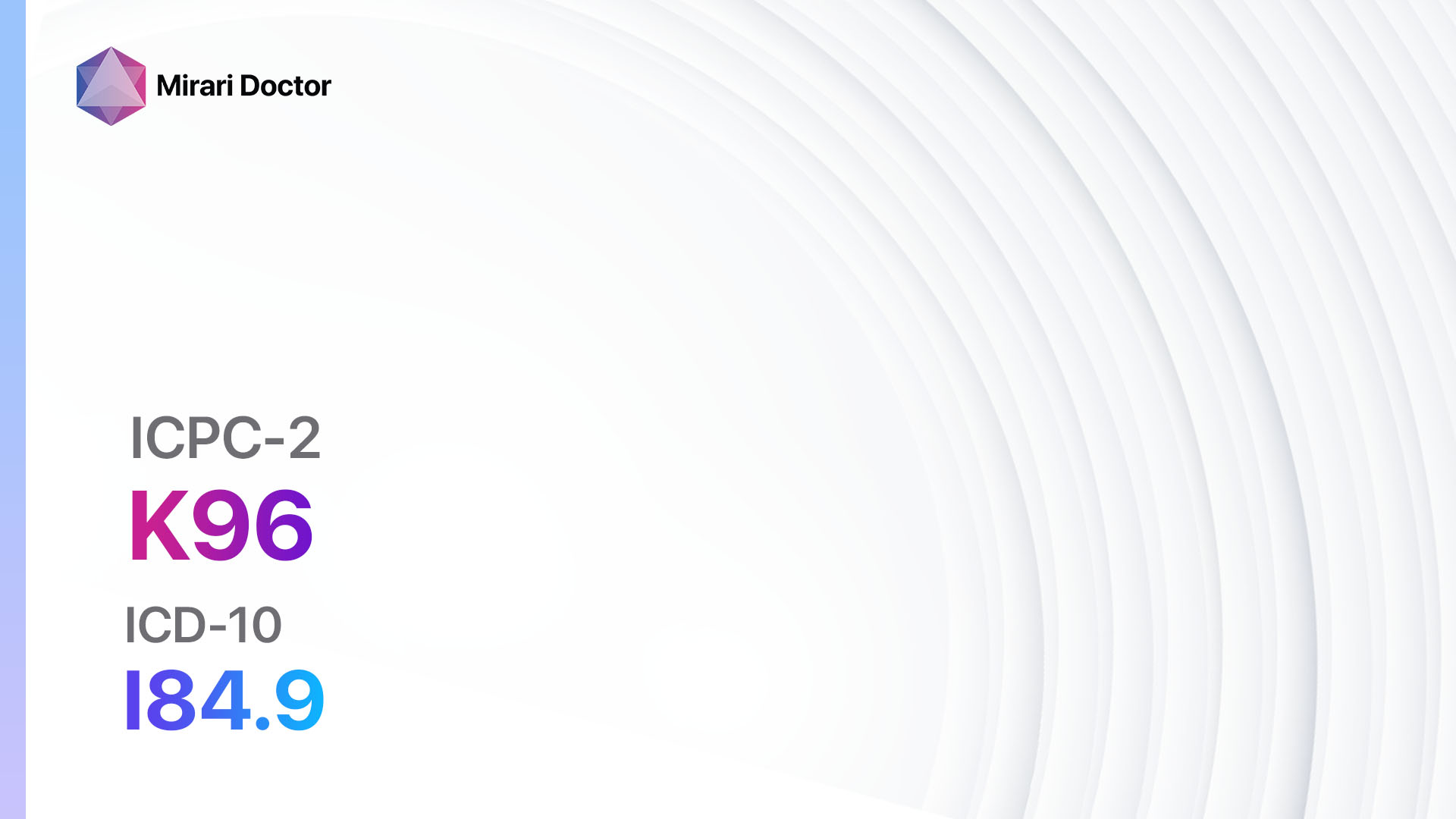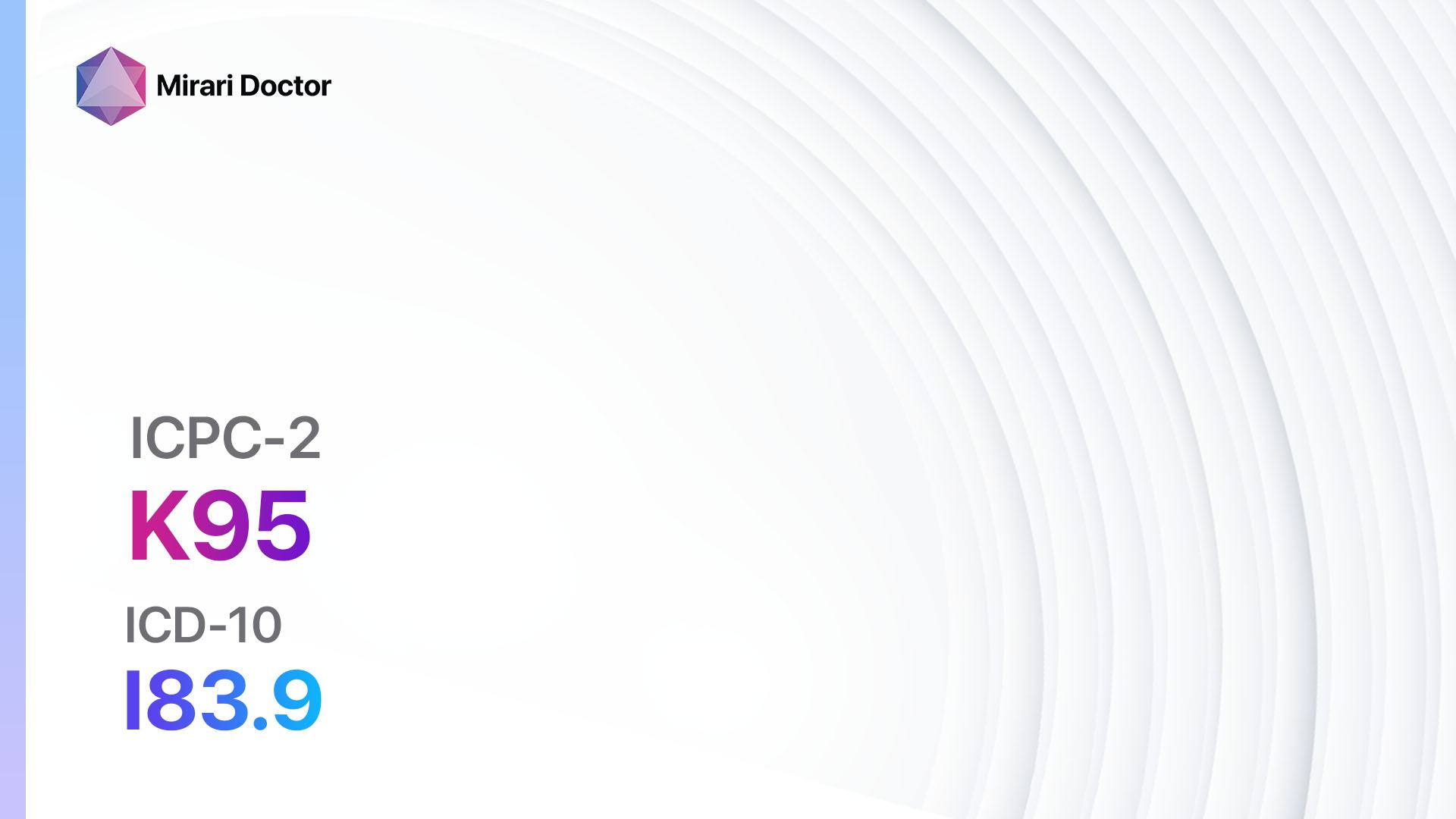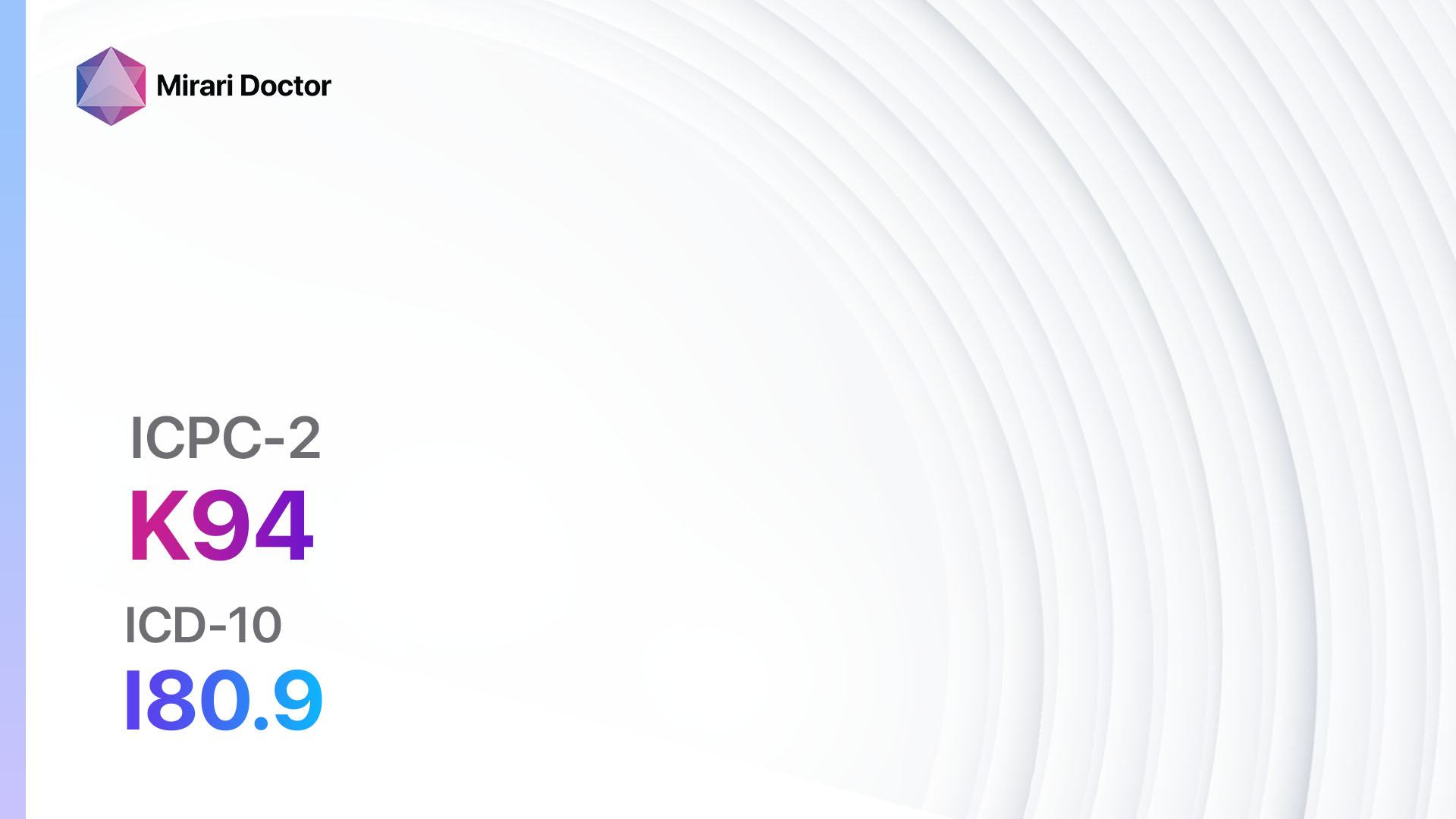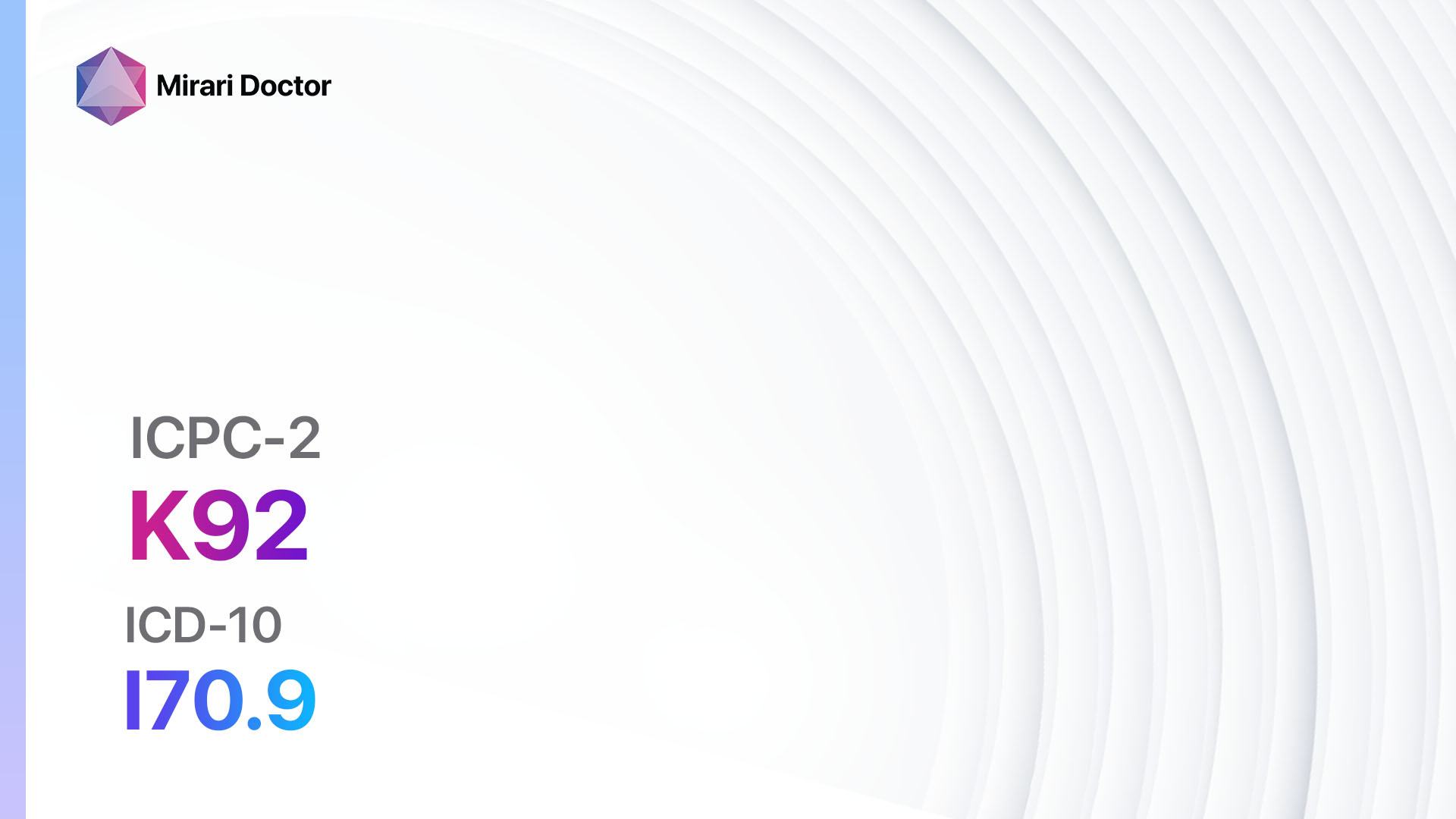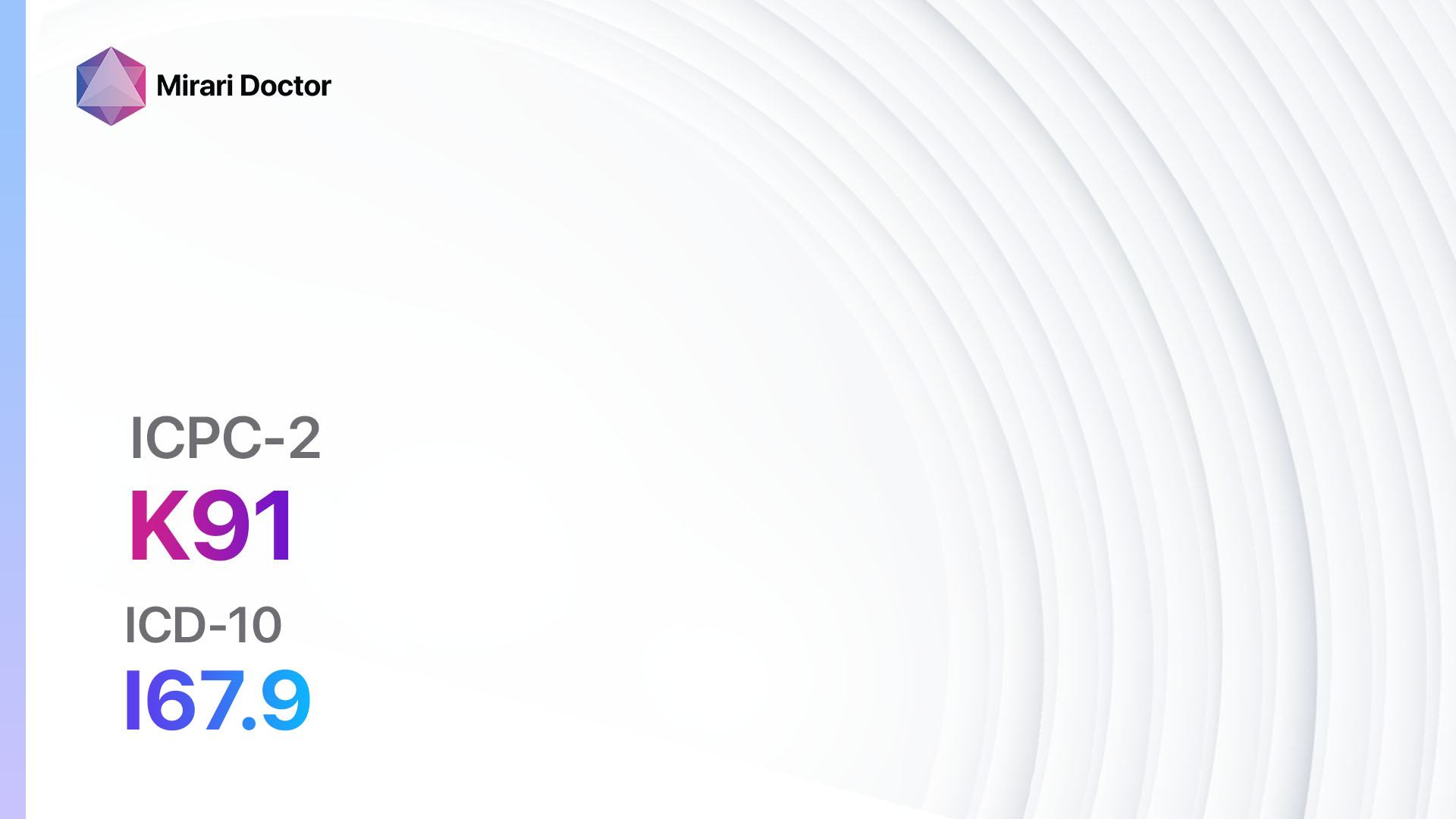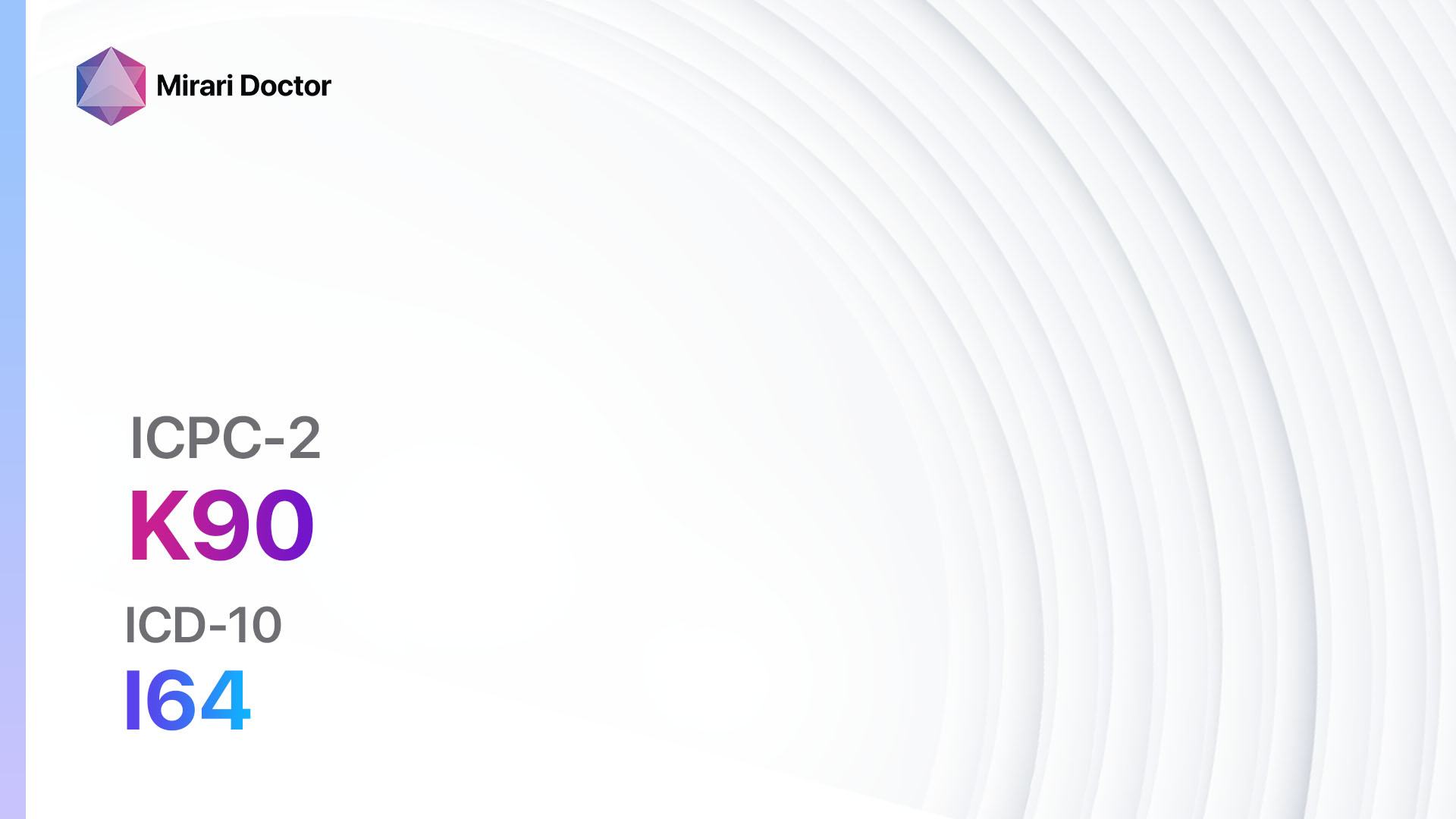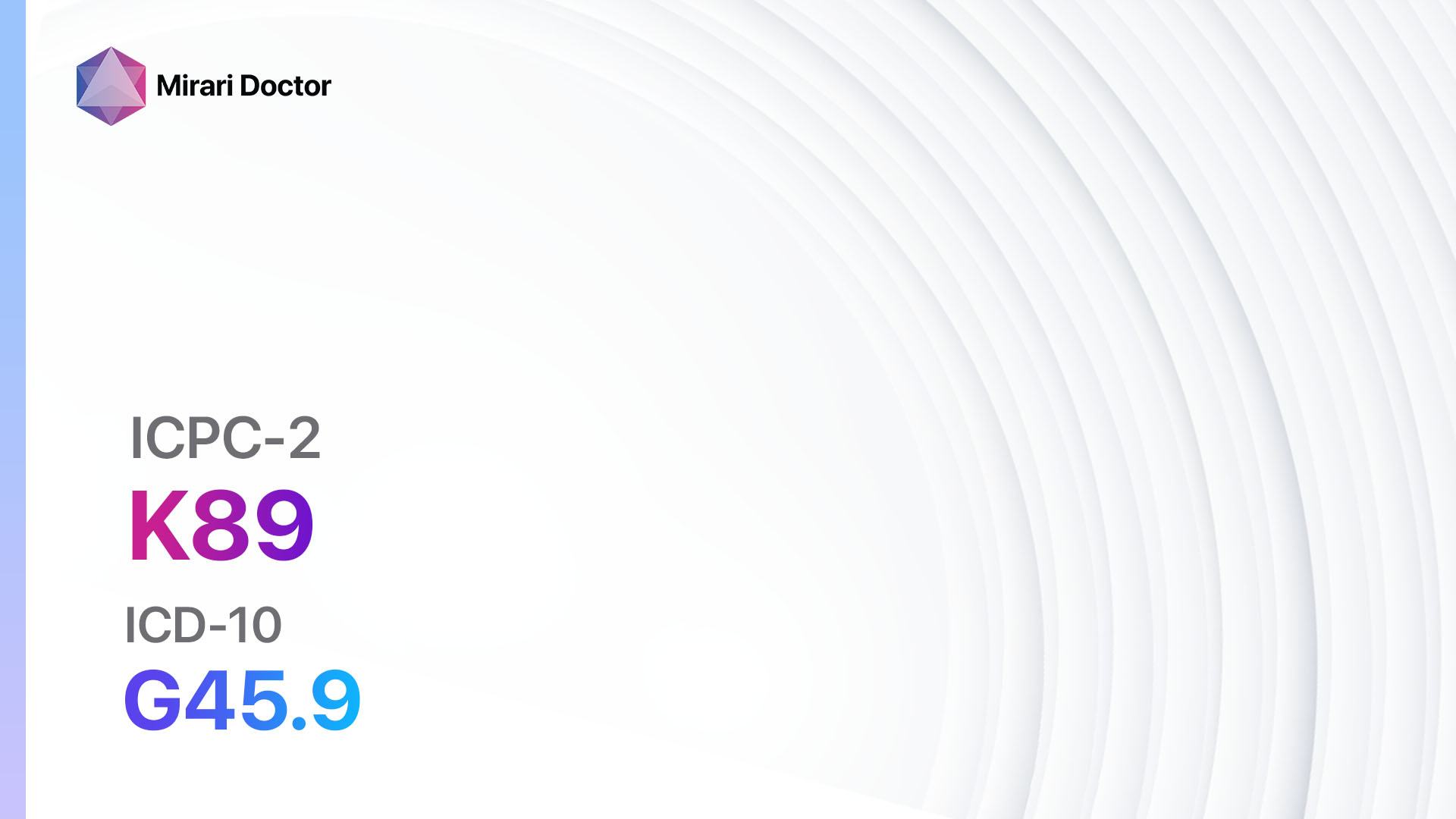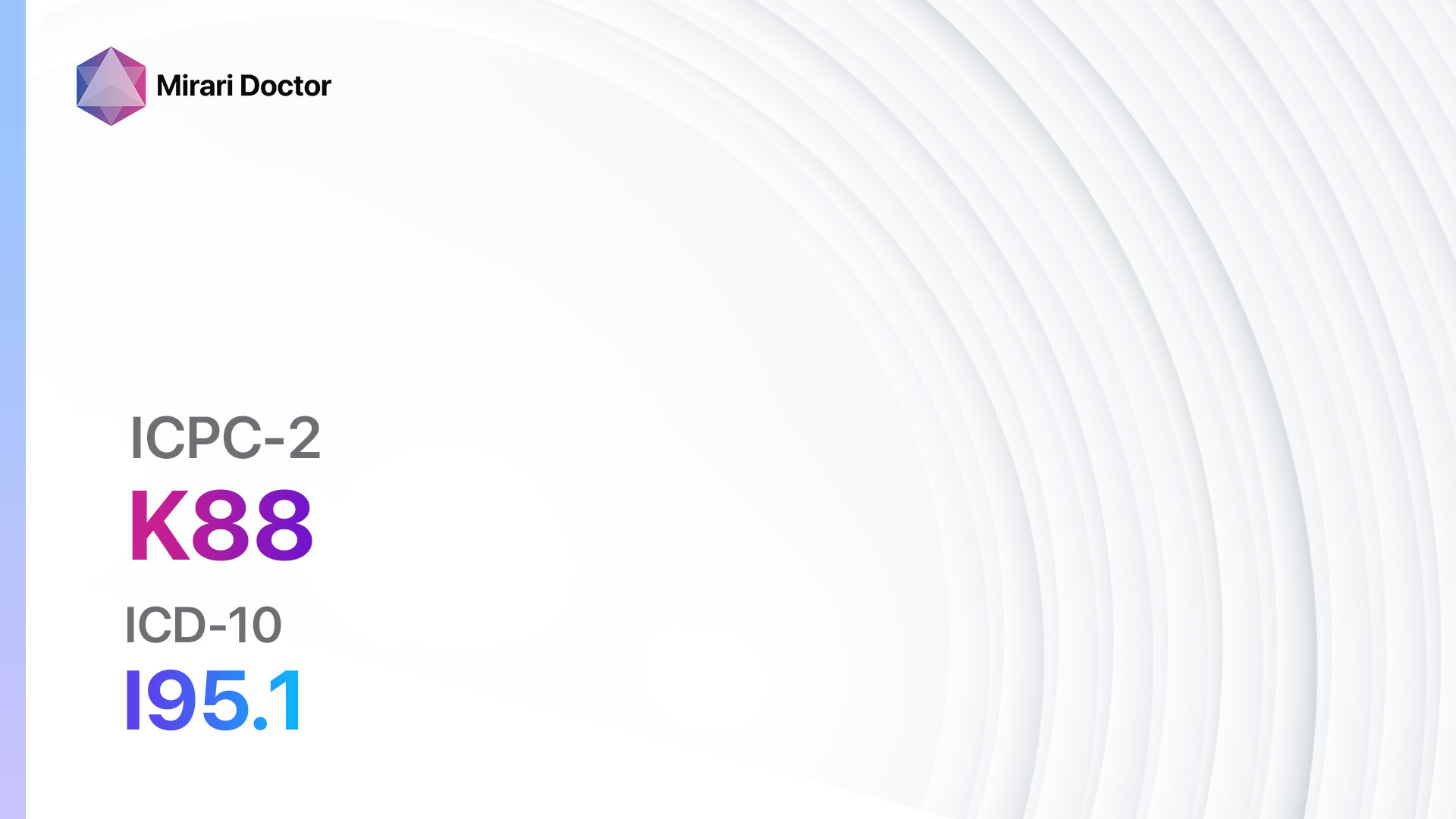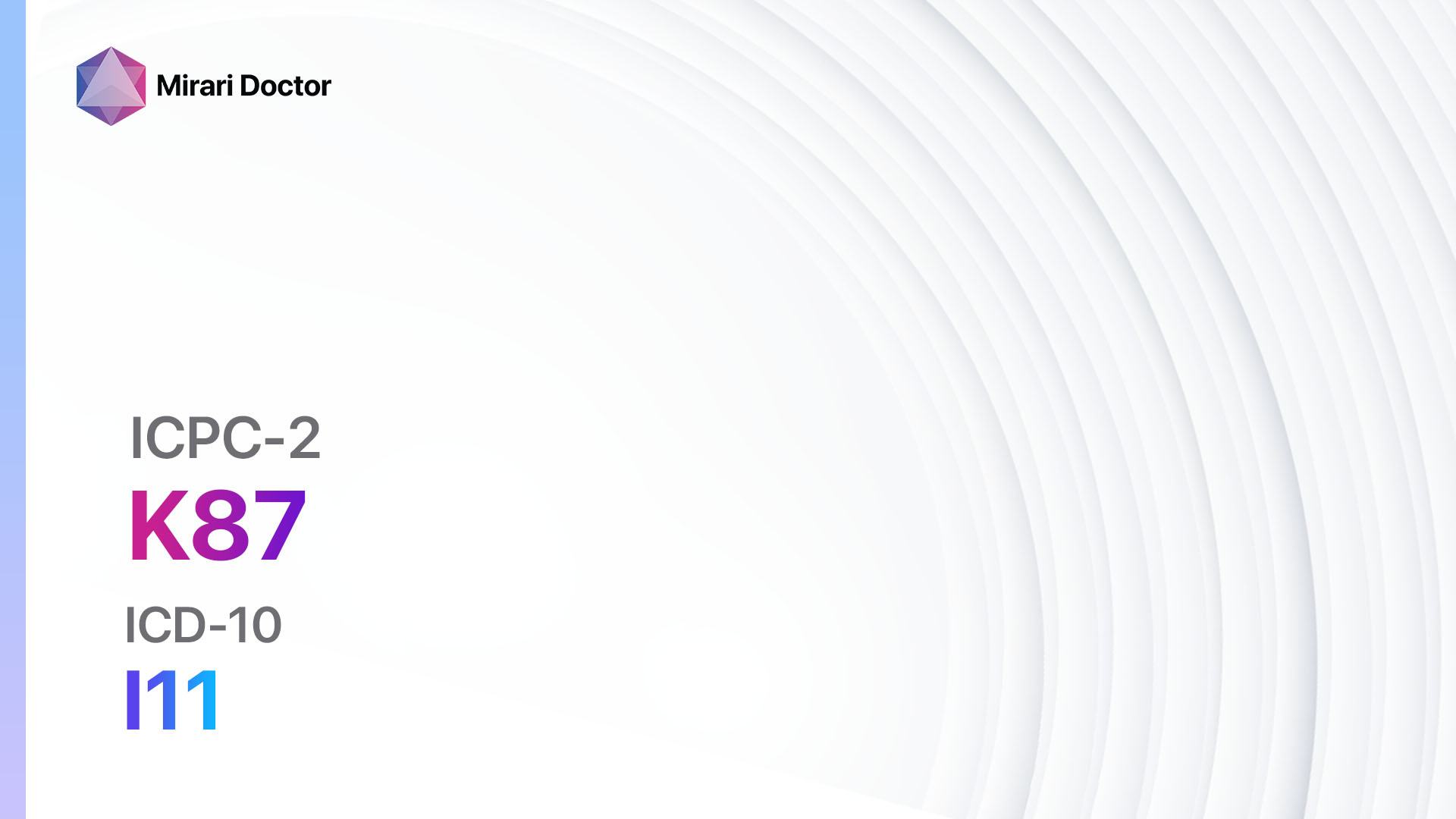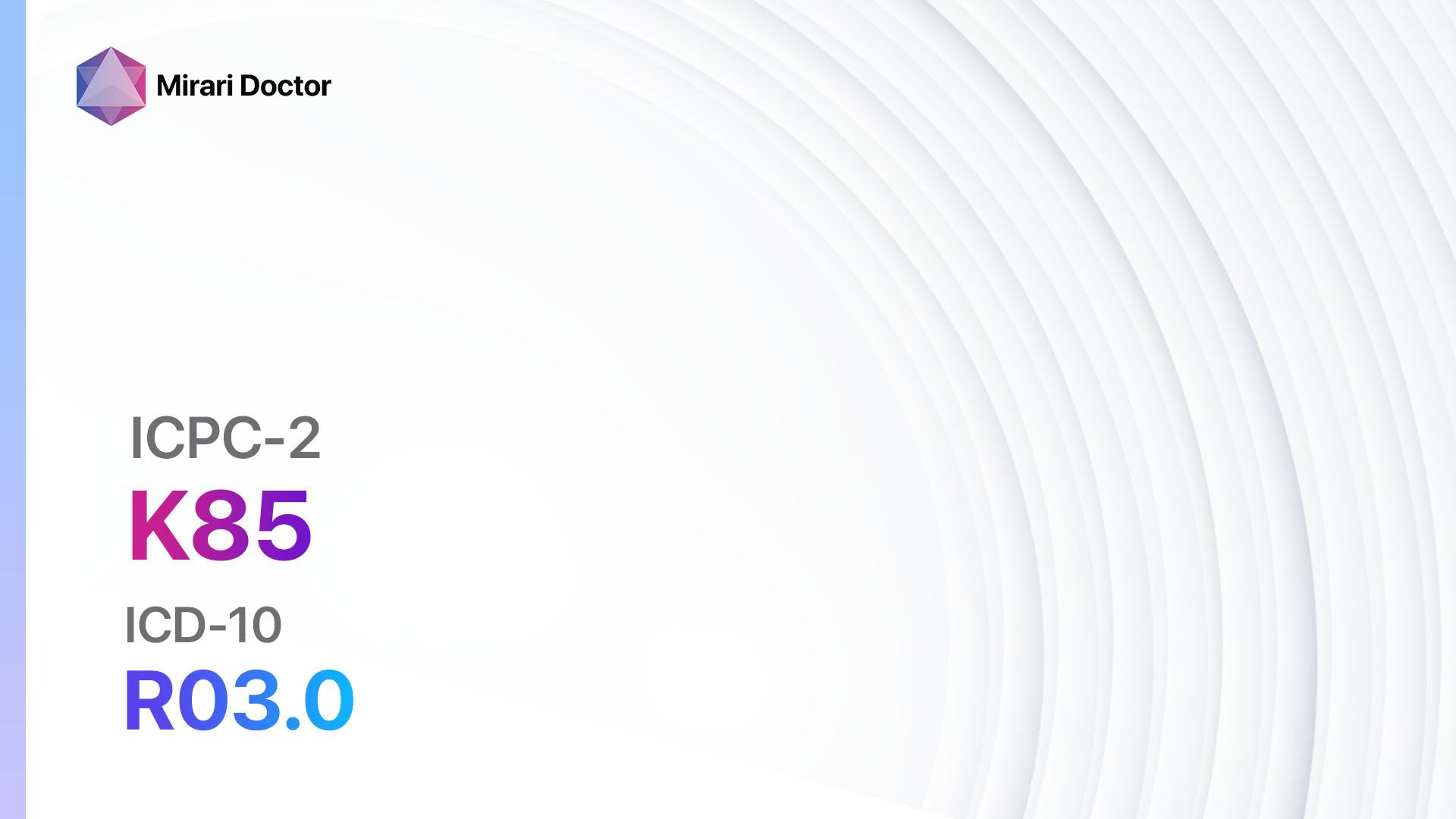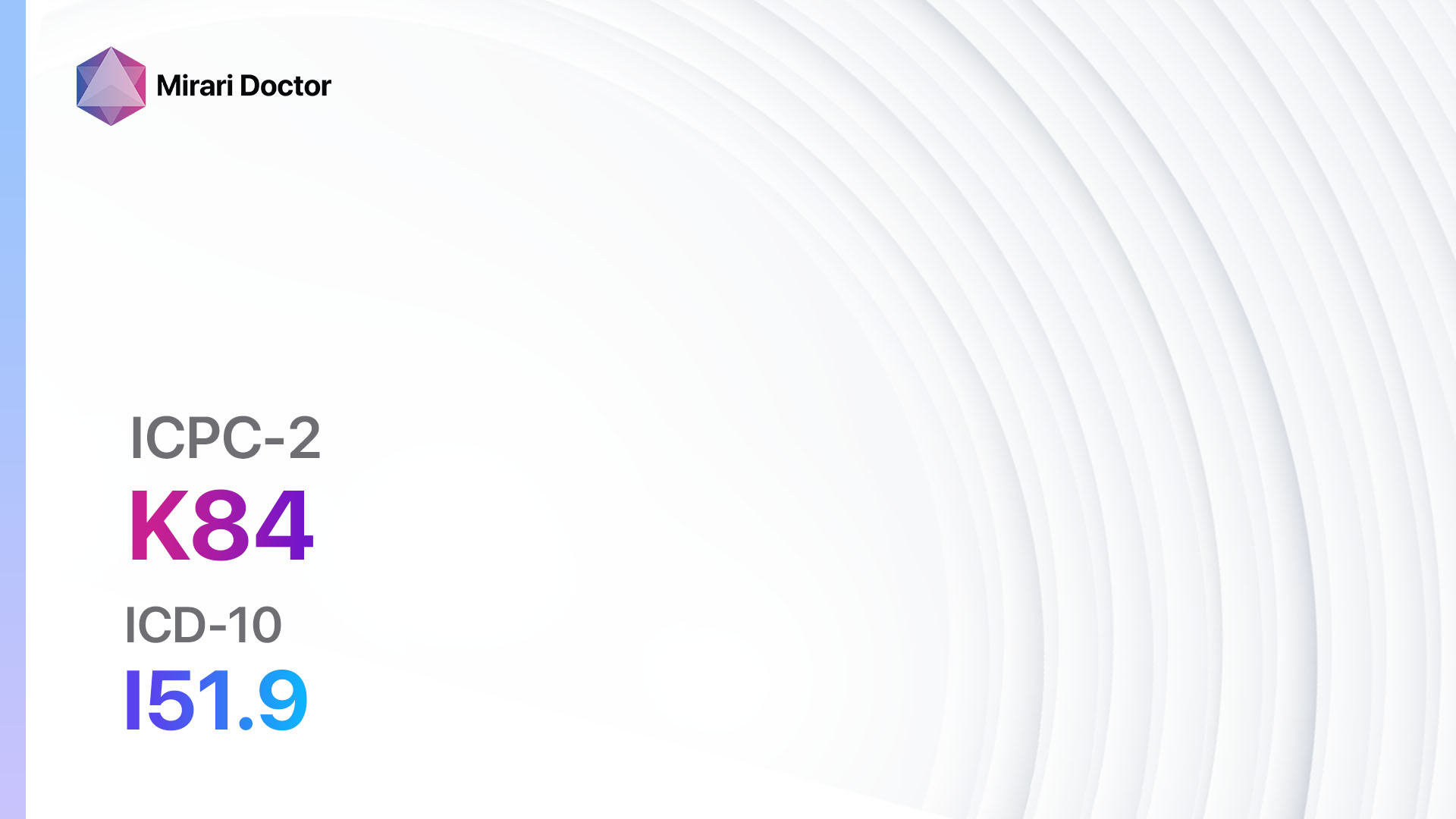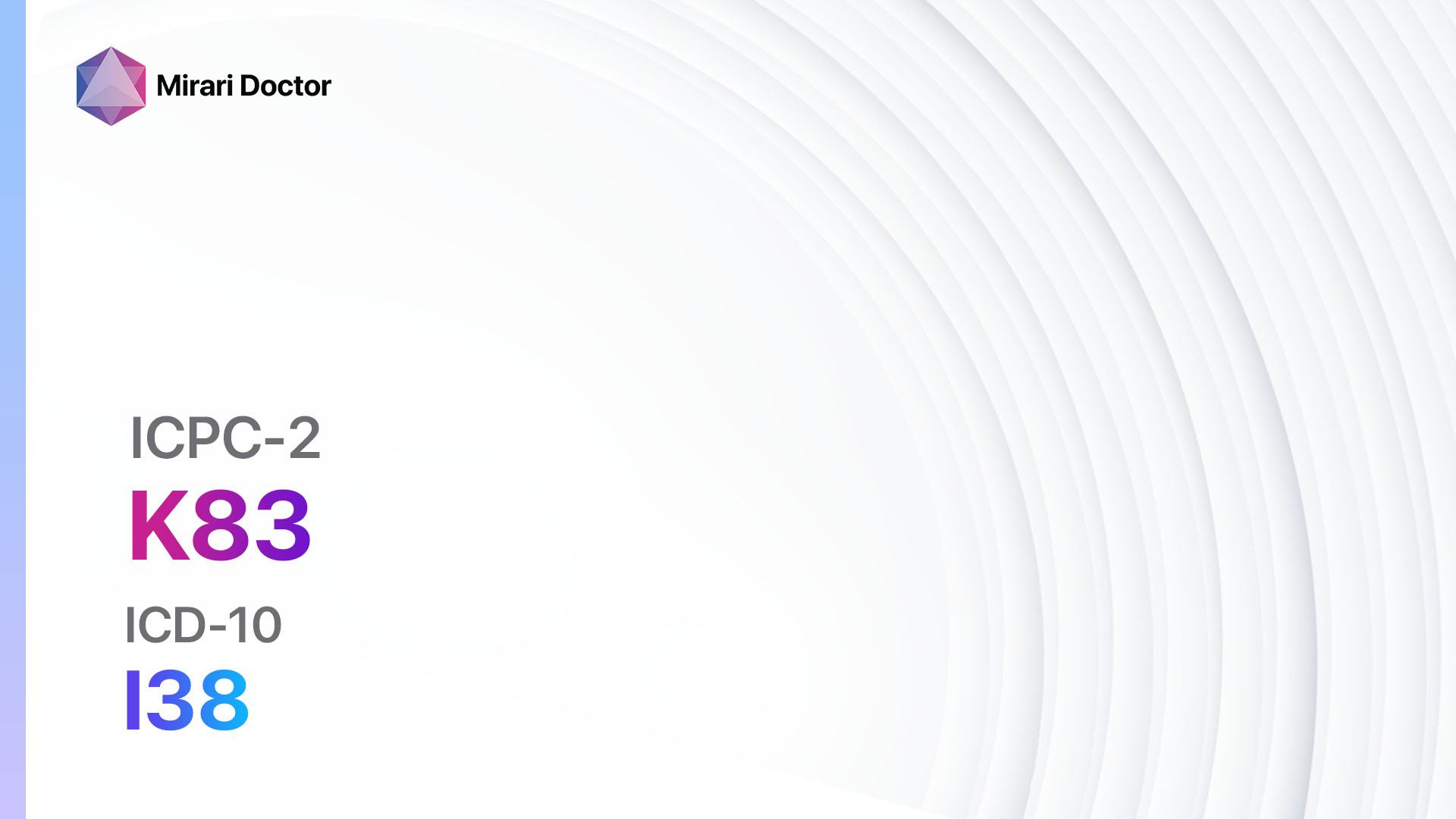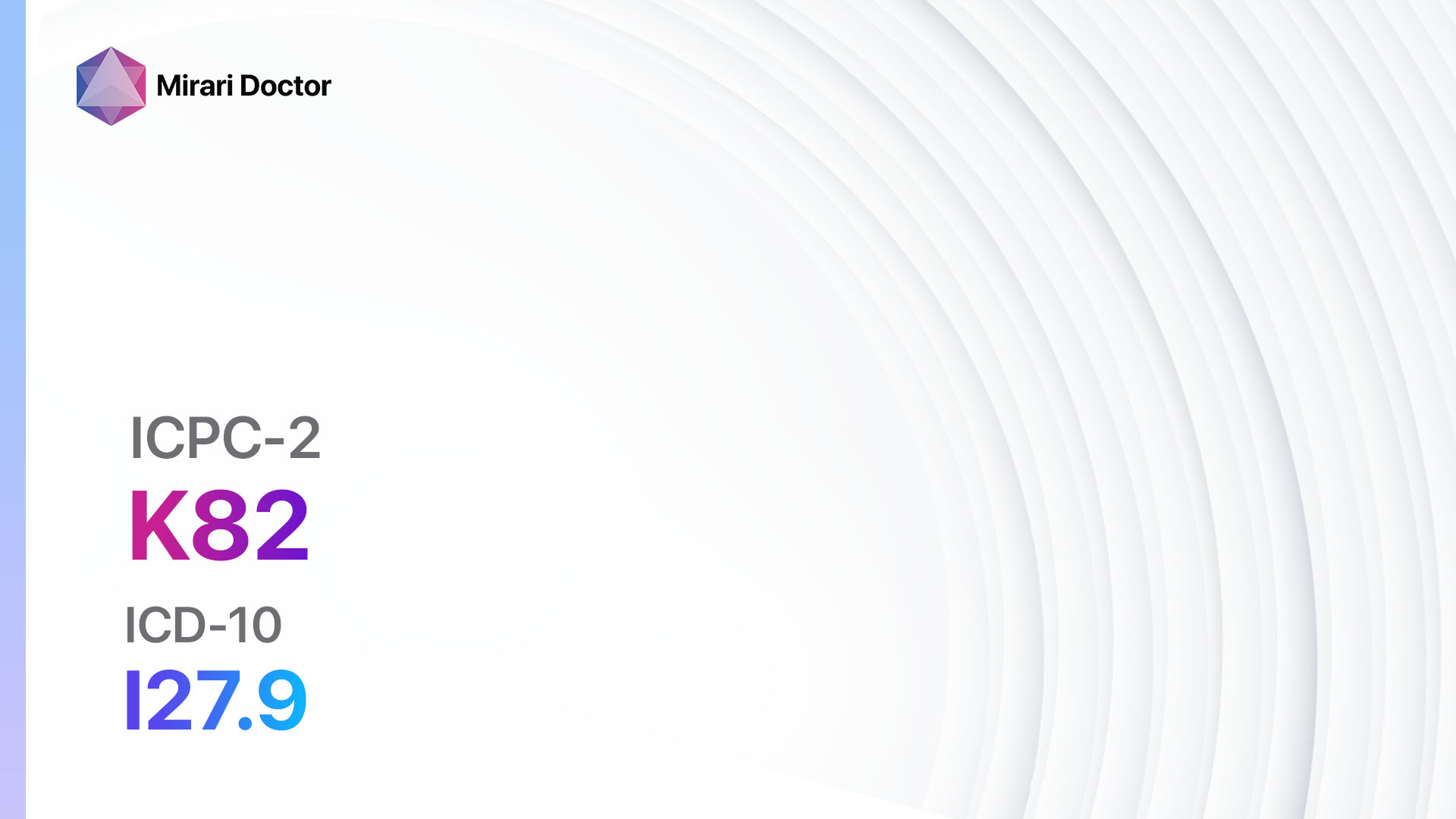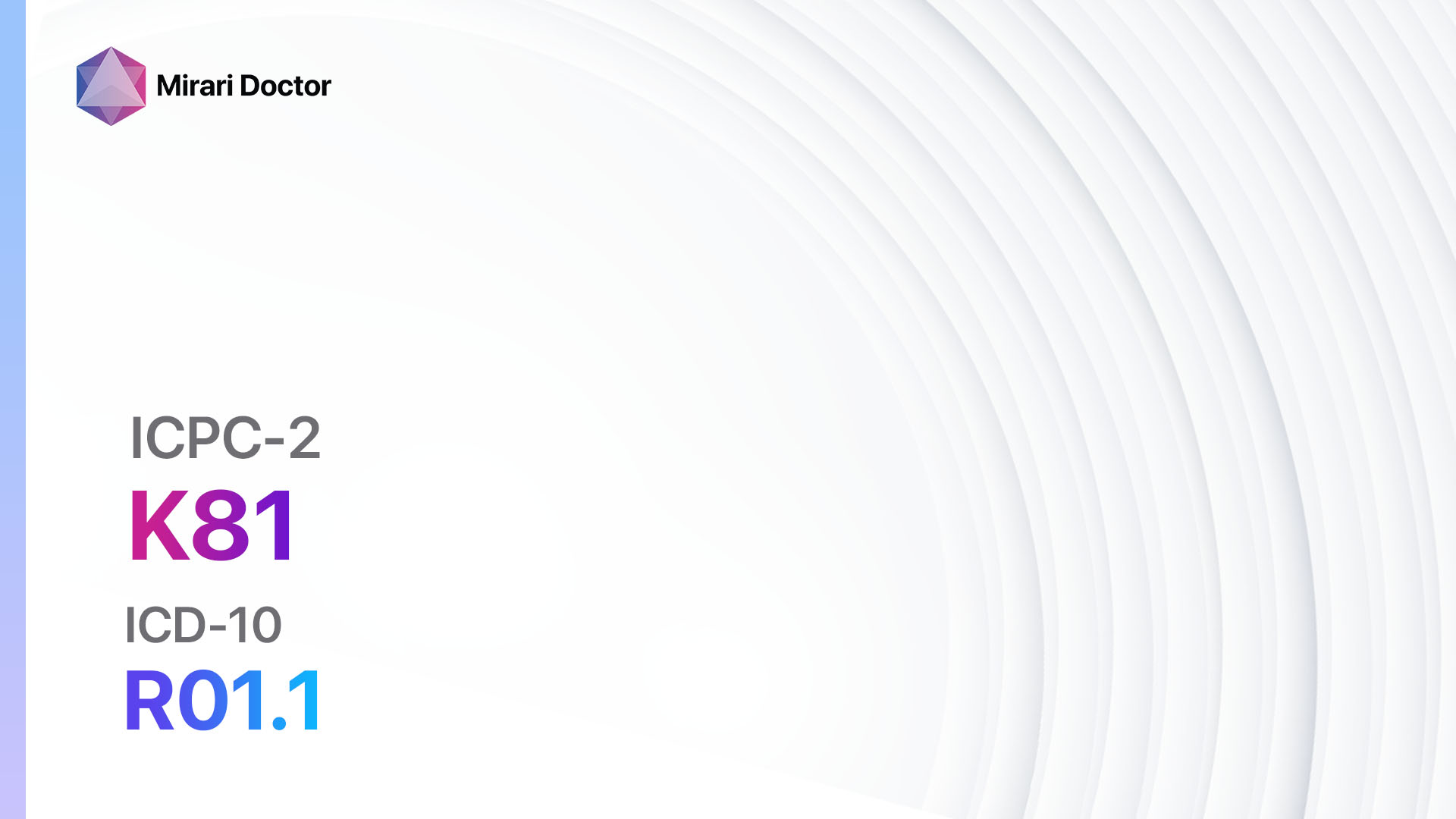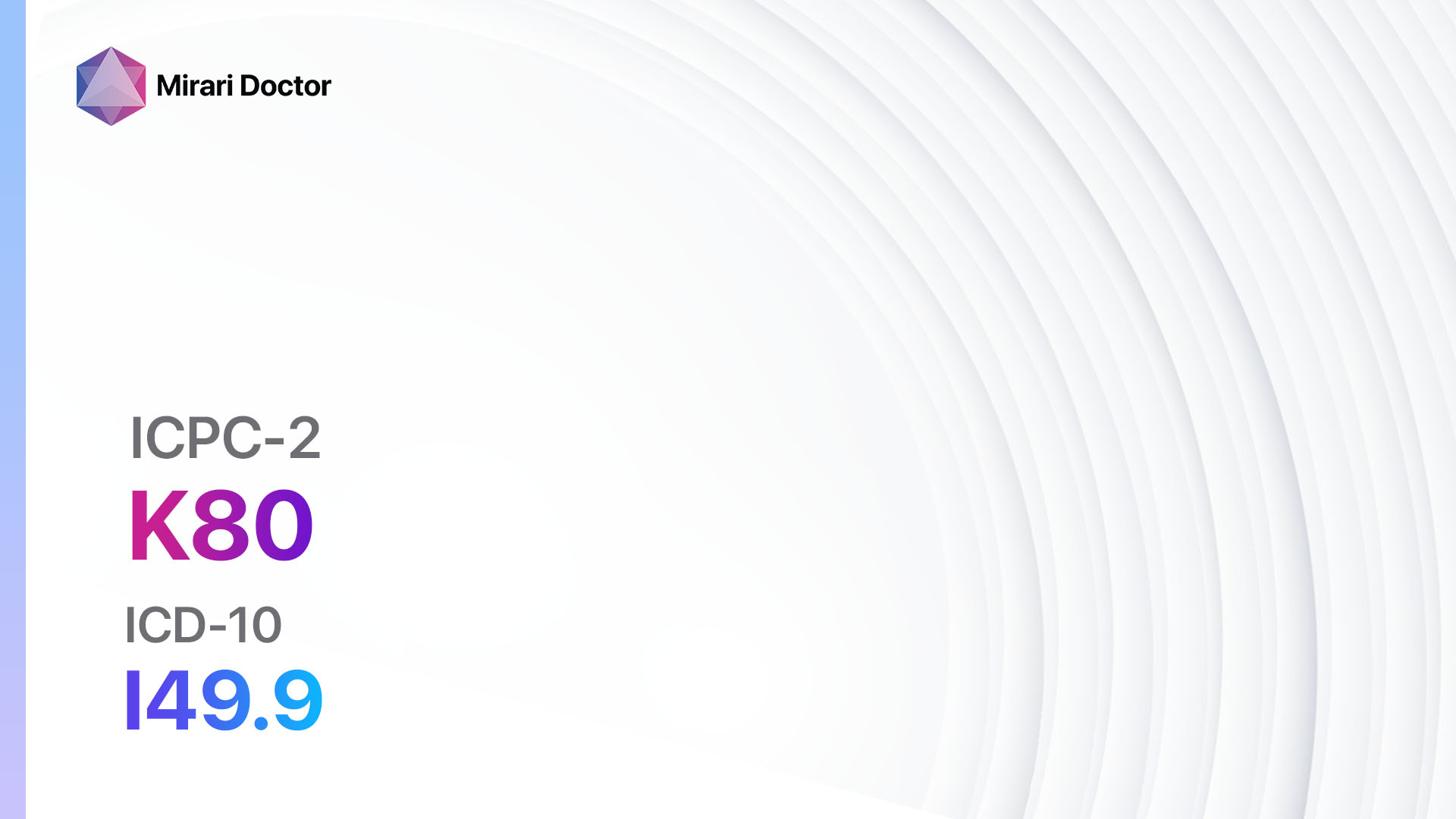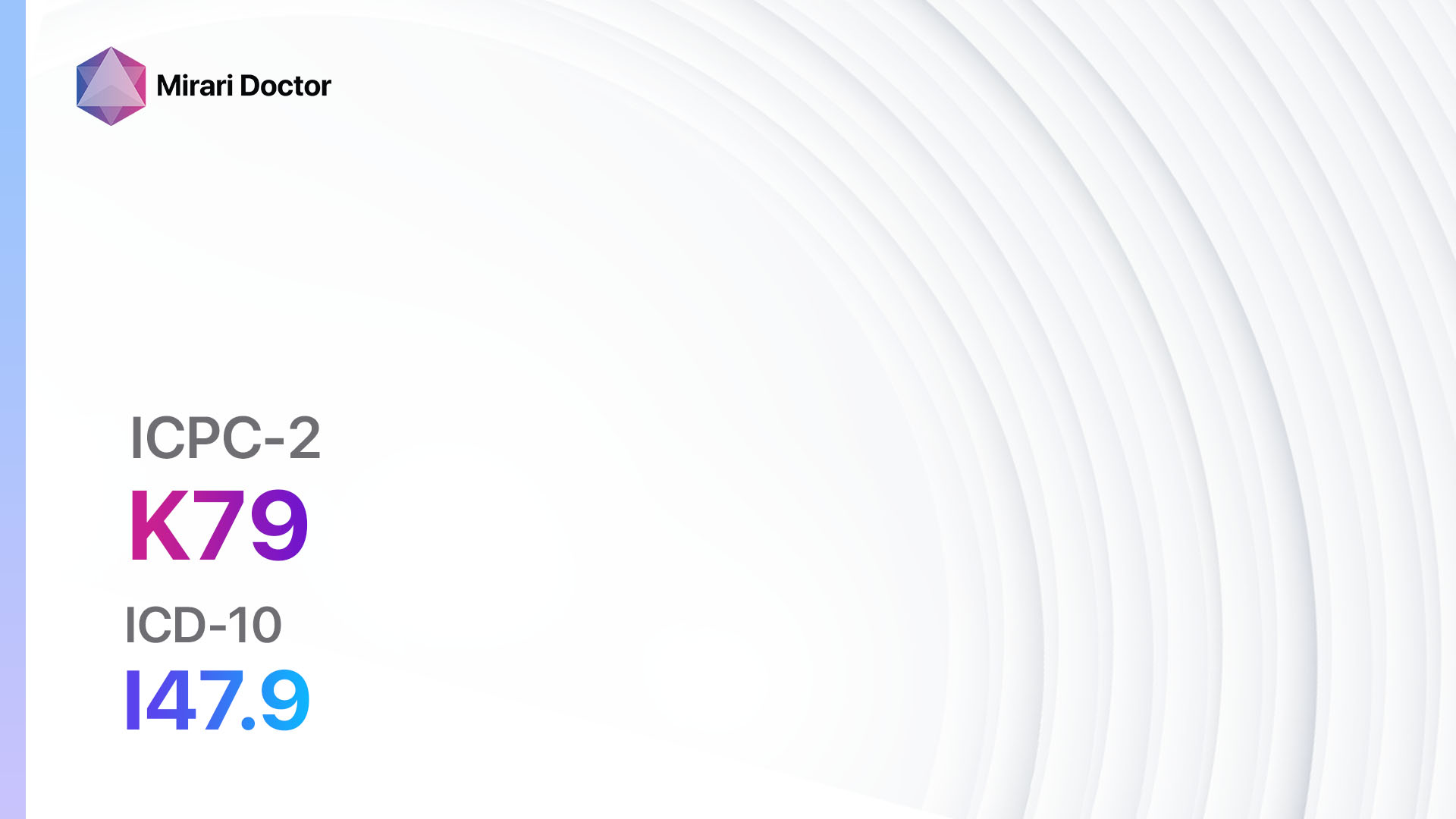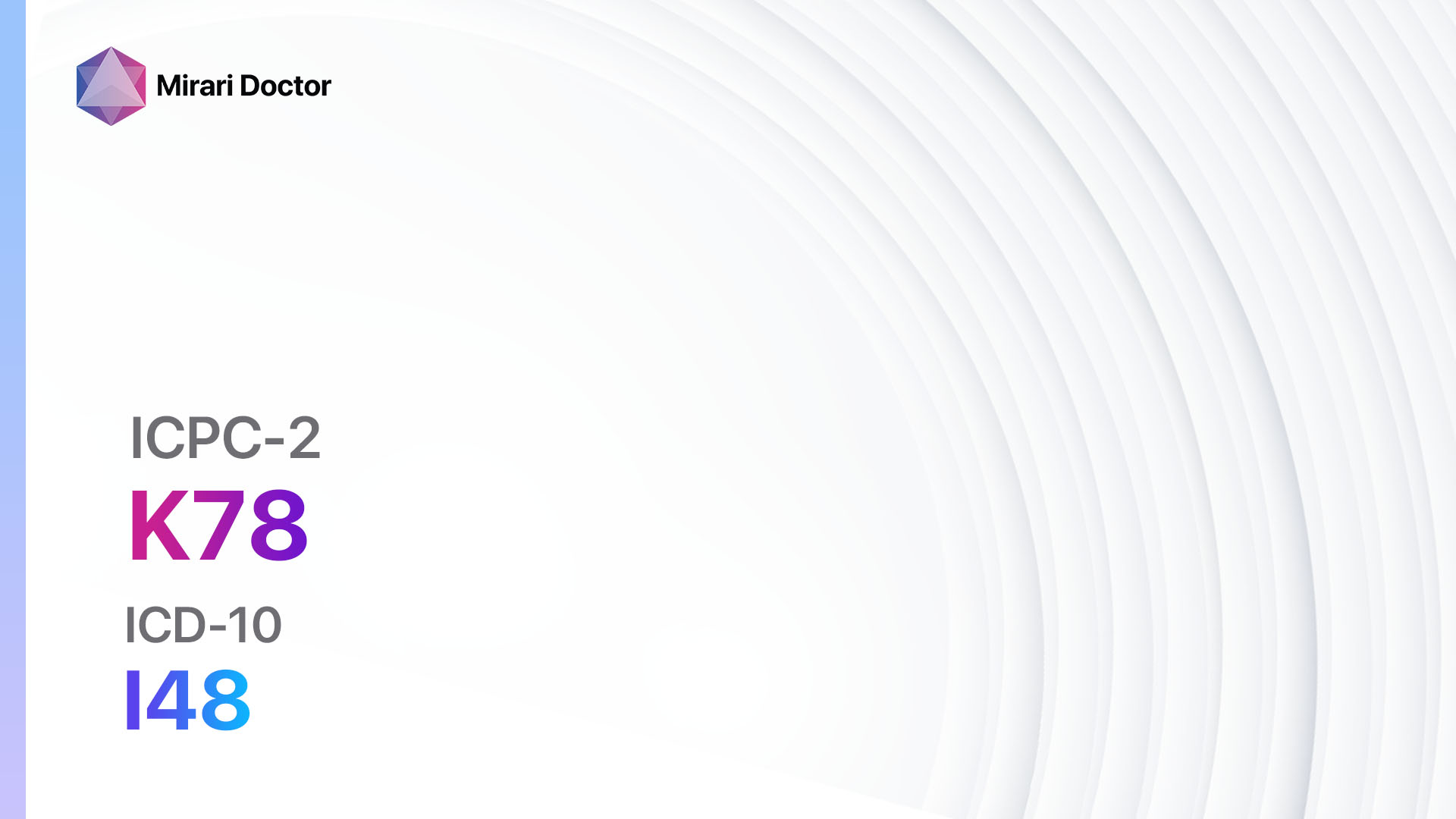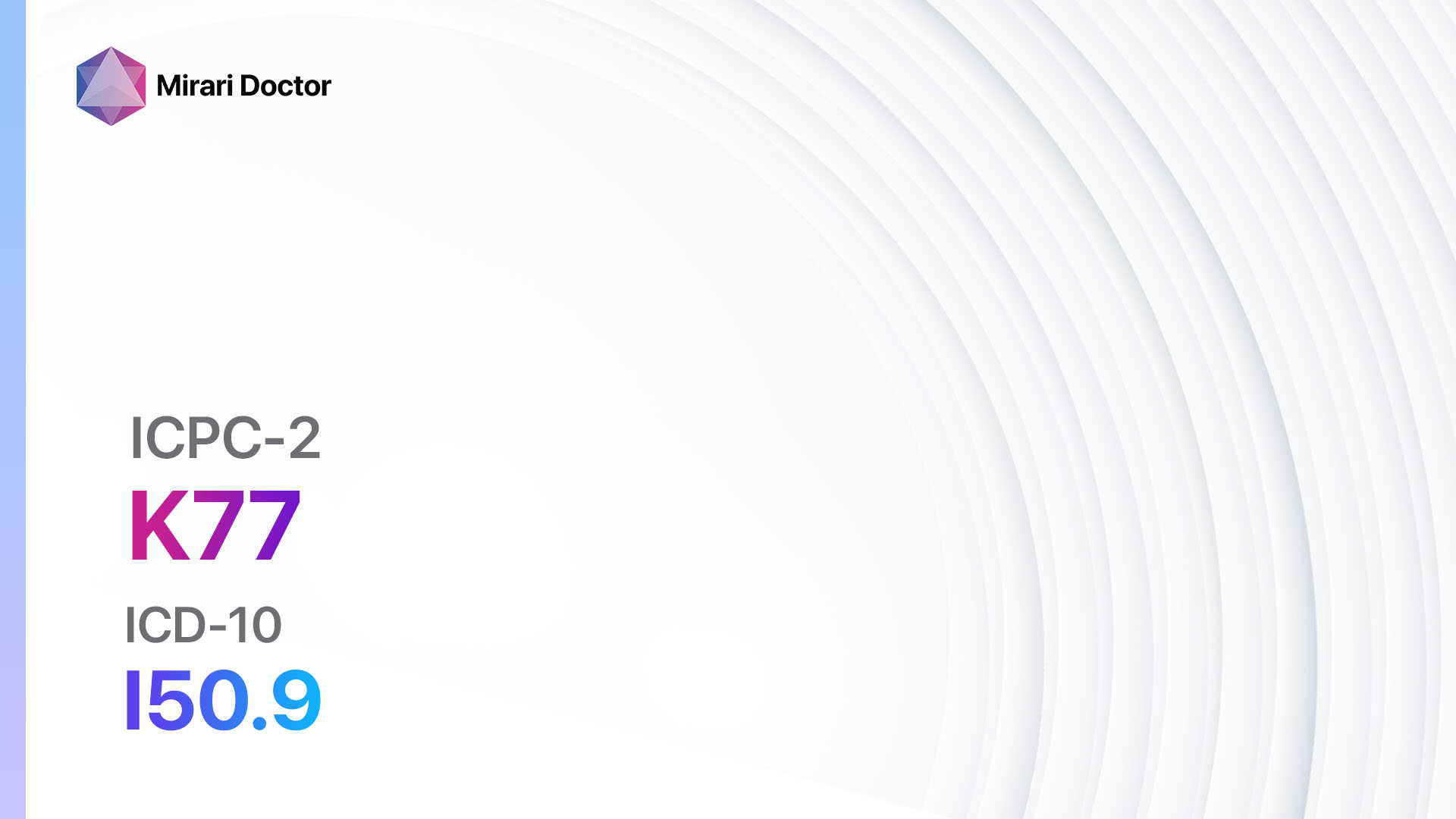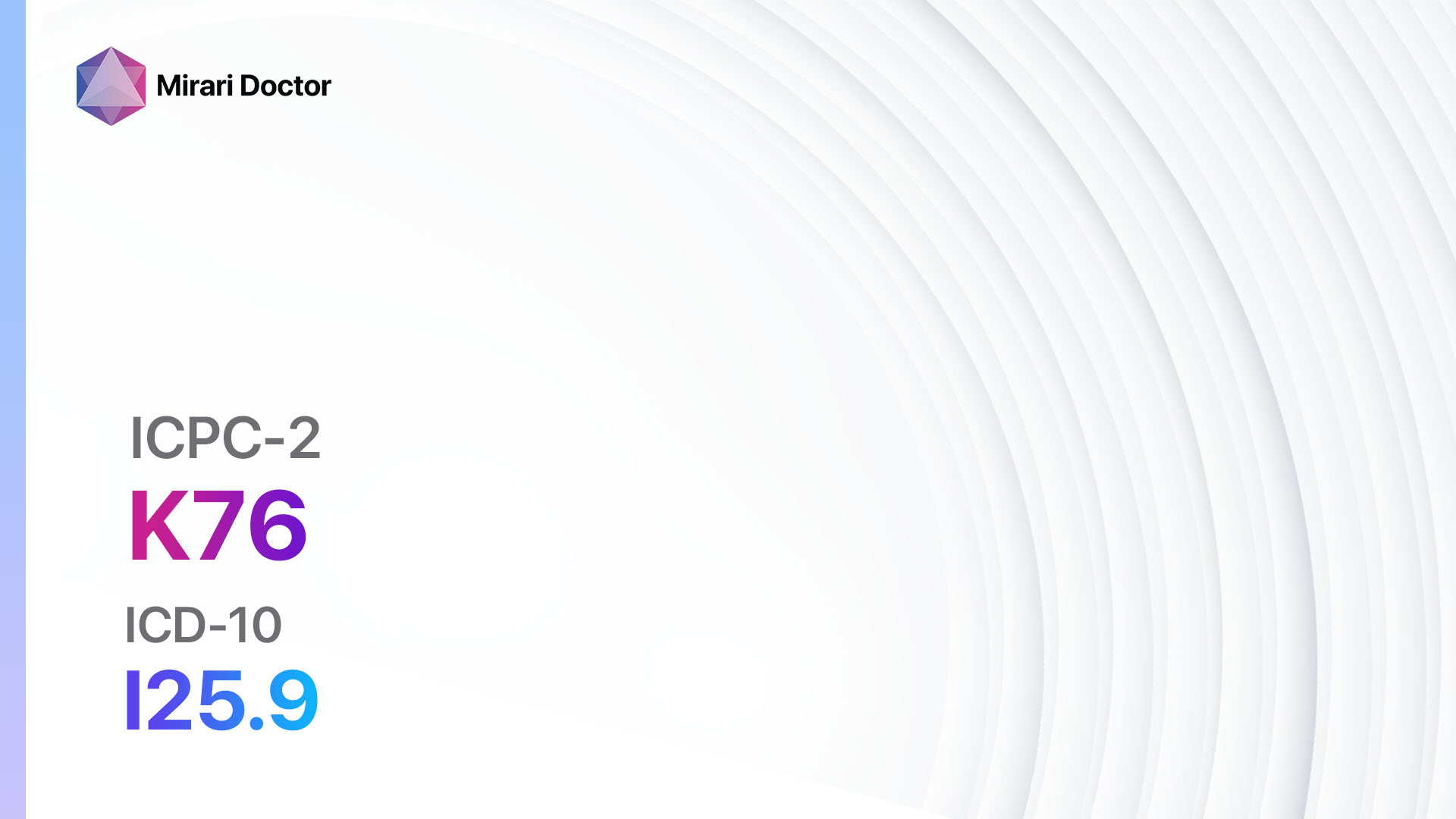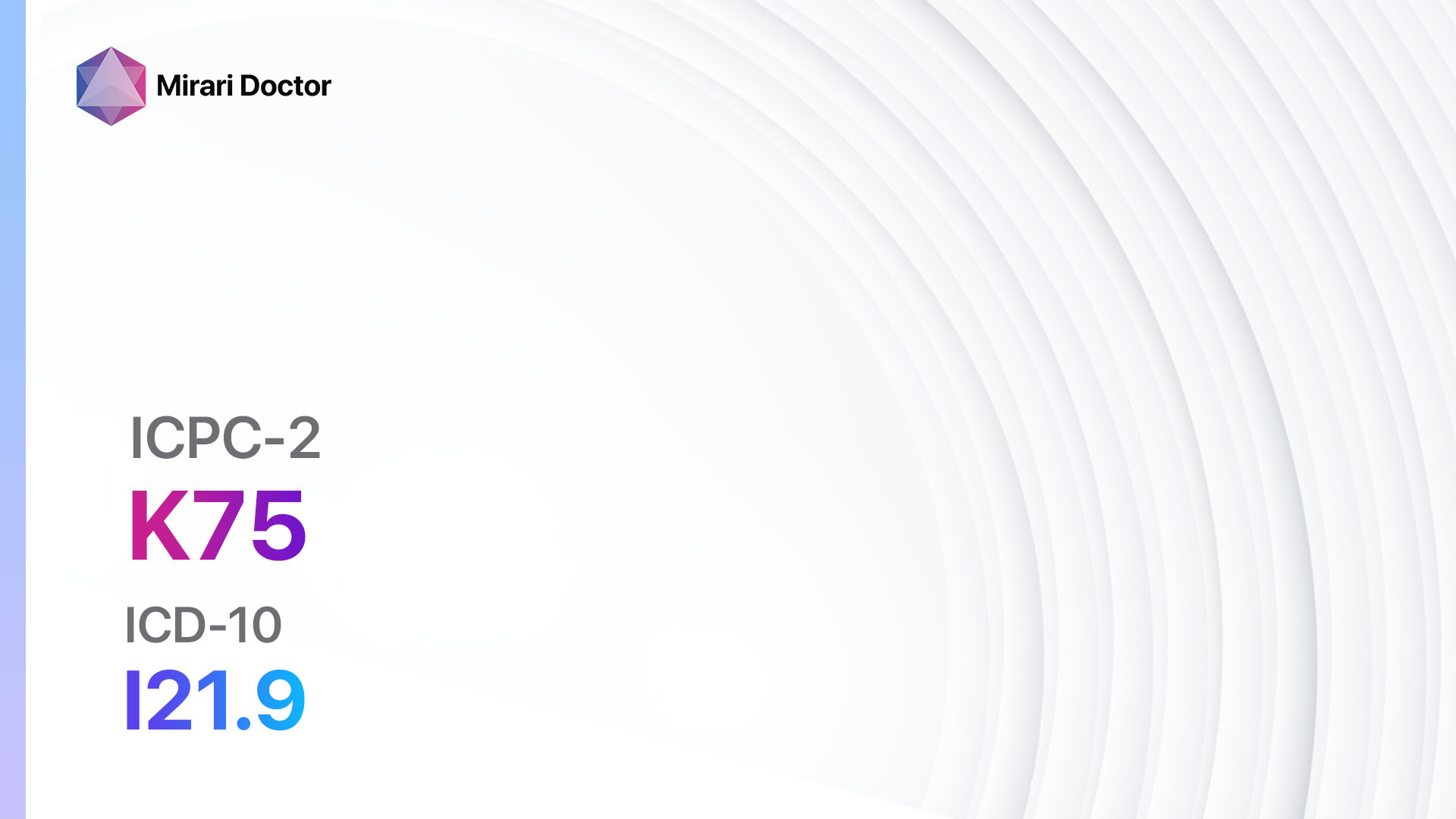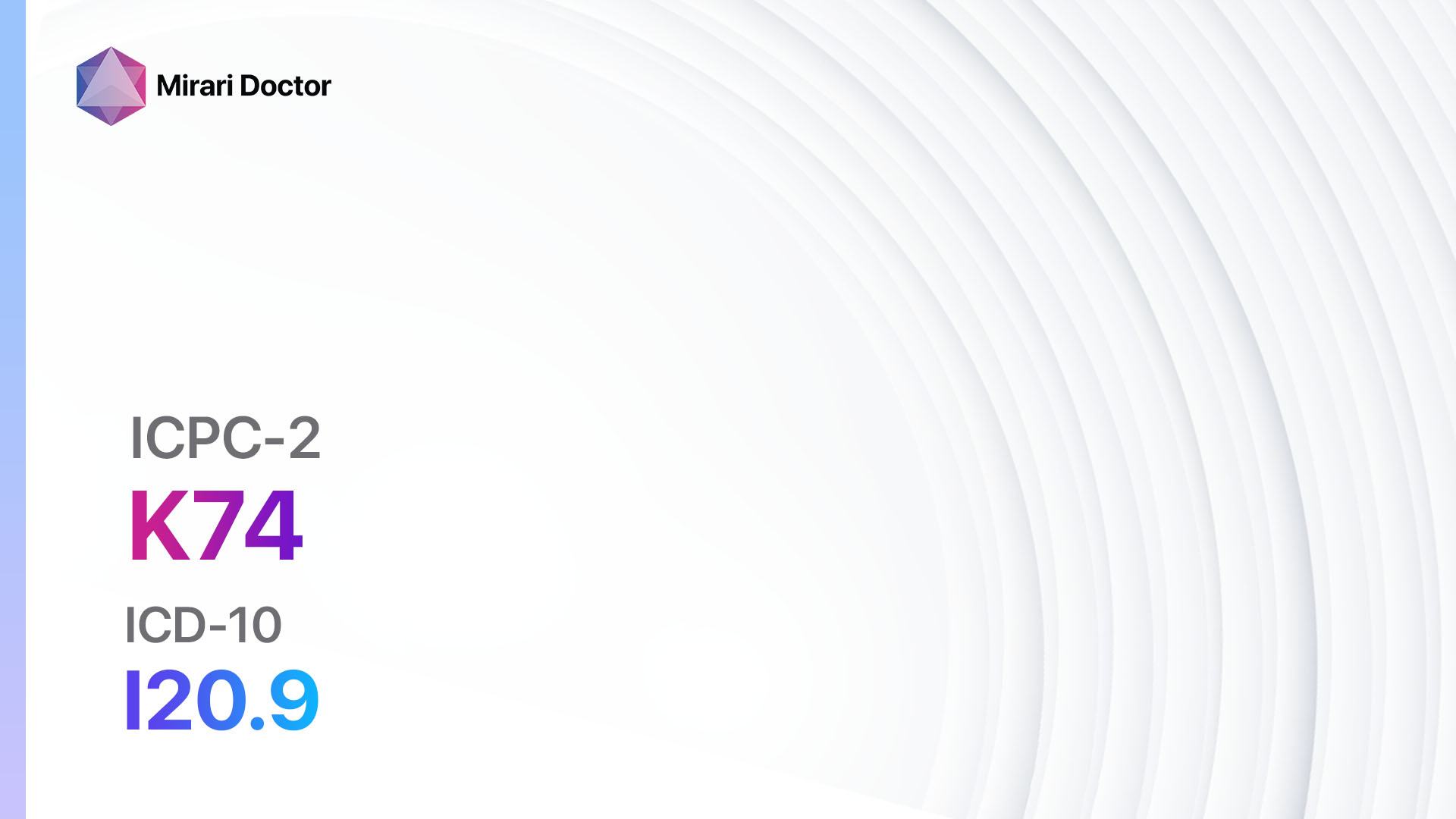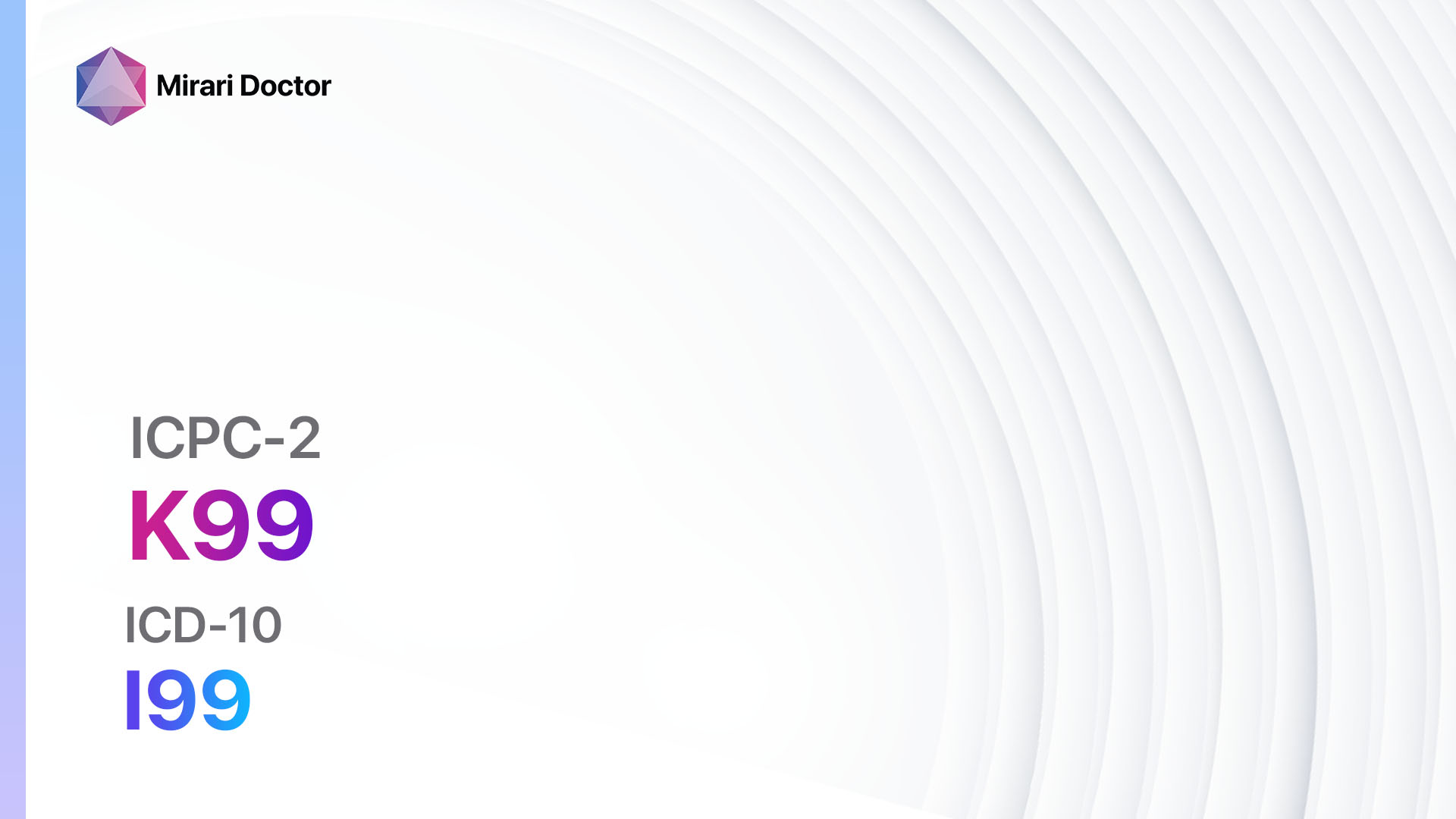
Introduction
Cardiovascular disease is a broad term that encompasses various conditions affecting the heart and blood vessels. This guide aims to provide an overview of cardiovascular disease other than the commonly known conditions such as coronary artery disease or heart failure. It will cover the symptoms, causes, diagnostic steps, possible interventions, and lifestyle modifications for managing this condition.
Codes
- ICPC-2 Code: K99 Cardiovascular disease other
- ICD-10 Code: I99 Other and unspecified disorders of circulatory system
Symptoms
- Chest pain or discomfort[1]
- Shortness of breath[2]
- Fatigue[3]
- Dizziness or lightheadedness[4]
- Irregular heartbeat[5]
- Swelling in the legs, ankles, or feet[6]
- Fainting or loss of consciousness[7]
Causes
- Hypertension (high blood pressure)[8]
- Hyperlipidemia (high cholesterol)[9]
- Diabetes[10]
- Smoking
- Obesity
- Family history of cardiovascular disease
- Sedentary lifestyle
- Stress
Diagnostic Steps
Medical History
- Gather information about the patient’s risk factors, such as smoking, obesity, or family history of cardiovascular disease.
- Assess the patient’s medical conditions, including hypertension, diabetes, or hyperlipidemia.
- Inquire about the presence of symptoms related to cardiovascular disease, such as chest pain or shortness of breath.
Physical Examination
- Measure blood pressure to assess for hypertension.
- Auscultate the heart for abnormal sounds or murmurs.
- Palpate peripheral pulses to evaluate blood flow.
- Inspect the extremities for signs of swelling or edema.
Laboratory Tests
- Lipid profile: Measures total cholesterol, LDL cholesterol, HDL cholesterol, and triglycerides.
- Fasting blood glucose: Assesses for diabetes or impaired glucose tolerance.
- Complete blood count: Checks for anemia or other blood disorders.
- Renal function tests: Evaluates kidney function, as impaired kidney function can contribute to cardiovascular disease.
- Cardiac biomarkers: Detects the presence of enzymes released during a heart attack or other cardiac events.
Diagnostic Imaging
- Electrocardiogram (ECG): Records the electrical activity of the heart to detect abnormalities in rhythm or structure.
- Echocardiogram: Uses ultrasound waves to create images of the heart and assess its structure and function.
- Stress test: Evaluates the heart’s response to physical activity or pharmacological stress.
- Cardiac CT scan: Provides detailed images of the heart and blood vessels to assess for blockages or abnormalities.
- Cardiac MRI: Uses magnetic fields and radio waves to create images of the heart and blood vessels.
Other Tests
- Coronary angiography: Invasive procedure that uses contrast dye and X-rays to visualize the coronary arteries and identify blockages.
- Transesophageal echocardiogram: Involves inserting a probe into the esophagus to obtain detailed images of the heart’s structure.
- Holter monitor: Records the heart’s electrical activity over a 24-hour period to detect arrhythmias or abnormalities.
Follow-up and Patient Education
- Schedule regular follow-up appointments to monitor the patient’s condition and adjust treatment as needed.
- Educate the patient about the importance of adhering to medication regimens, lifestyle modifications, and regular check-ups.
- Provide resources for support groups or counseling services to help the patient cope with the emotional and psychological impact of cardiovascular disease.
Possible Interventions
Traditional Interventions
Medications:
Top 5 drugs for Cardiovascular disease other:
- Antiplatelet agents (e.g., Clopidogrel, Aspirin):
- Cost: Aspirin is inexpensive (<$10/month). Clopidogrel is $10-$100/month for generic.
- Contraindications: Active bleeding, peptic ulcer disease.
- Side effects: Upset stomach, bleeding.
- Severe side effects: Severe bleeding, allergic reactions.
- Drug interactions: NSAIDs, other blood thinners.
- Warning: Risk of bleeding.
- Beta-blockers (e.g., Metoprolol, Atenolol):
- Cost: Generic versions are typically <$30/month.
- Contraindications: Severe bradycardia, uncontrolled heart failure.
- Side effects: Fatigue, dizziness, bradycardia.
- Severe side effects: Bronchospasm, heart block.
- Drug interactions: Calcium channel blockers, insulin.
- Warning: Should not be abruptly stopped.
- ACE inhibitors (e.g., Ramipril, Lisinopril):
- Cost: Generics can be $10-$50/month.
- Contraindications: History of angioedema with ACE inhibitors, renal artery stenosis.
- Side effects: Cough, elevated blood urea nitrogen.
- Severe side effects: Angioedema, hyperkalemia.
- Drug interactions: Potassium supplements, NSAIDs.
- Warning: Monitoring of renal function and potassium is required.
- Calcium channel blockers (e.g., Amlodipine, Diltiazem):
- Cost: Generic versions can be $10-$50/month.
- Contraindications: Severe hypotension, heart failure.
- Side effects: Edema, dizziness, flushing.
- Severe side effects: Bradycardia, heart block.
- Drug interactions: Beta-blockers, grapefruit juice.
- Warning: Should not be abruptly stopped.
- Diuretics (e.g., Hydrochlorothiazide, Furosemide):
- Cost: Generic versions can be <$10/month.
- Contraindications: Severe renal impairment, anuria.
- Side effects: Frequent urination, electrolyte imbalances.
- Severe side effects: Hypotension, dehydration.
- Drug interactions: NSAIDs, lithium.
- Warning: Monitor electrolyte levels and renal function.
Alternative Drugs:
- Angiotensin receptor blockers (e.g., Losartan, Valsartan): Alternative to ACE inhibitors for patients who cannot tolerate them.
- Statins (e.g., Atorvastatin, Simvastatin, Rosuvastatin): Used to lower cholesterol levels and reduce the risk of cardiovascular events.
- Nitrates (e.g., Nitroglycerin): Relieve chest pain by dilating blood vessels and improving blood flow to the heart.
- Antiarrhythmics (e.g., Amiodarone, Flecainide): Used to manage abnormal heart rhythms.
Surgical Procedures:
- Angioplasty and stent placement: A catheter is used to place a stent to open up narrowed arteries. Cost: $15,000 to $50,000.
- Coronary artery bypass surgery (CABG): Redirects blood around blocked or narrowed coronary arteries. Cost: $70,000 to $200,000.
Alternative Interventions
- Acupuncture: May help improve blood flow and reduce pain. Cost: $60-$120 per session.
- Chelation therapy: Controversial treatment involving the administration of chelating agents to remove heavy metals from the body. Cost: $75-$150 per session.
- Hyperbaric oxygen therapy: Involves breathing pure oxygen in a pressurized chamber to increase oxygen delivery to tissues. Cost: $200-$300 per session.
- Herbal supplements: Some herbs, such as garlic and ginkgo biloba, may have potential benefits for improving circulation. Cost: Varies depending on the specific supplement.
Lifestyle Interventions
- Regular exercise: Engaging in aerobic activities, such as walking or swimming, can improve cardiovascular health. Cost: Varies (e.g., gym membership, equipment).
- Healthy diet: Emphasize a diet rich in fruits, vegetables, whole grains, lean proteins, and healthy fats. Cost: Varies depending on food choices.
- Smoking cessation: Quitting smoking can significantly reduce the risk of cardiovascular disease. Cost: Varies (e.g., nicotine replacement therapy, counseling).
- Weight management: Achieving and maintaining a healthy weight can improve cardiovascular health. Cost: Varies (e.g., diet programs, weight loss medications).
- Stress management: Techniques such as meditation, yoga, or counseling can help reduce stress levels. Cost: Varies (e.g., meditation apps, therapy sessions).
It is important to note that the cost ranges provided are approximate and may vary depending on the location and availability of the interventions.
Mirari Cold Plasma Alternative Intervention
Understanding Mirari Cold Plasma
- Safe and Non-Invasive Treatment: Mirari Cold Plasma is a safe and non-invasive treatment option for various skin conditions. It does not require incisions, minimizing the risk of scarring, bleeding, or tissue damage.
- Efficient Extraction of Foreign Bodies: Mirari Cold Plasma facilitates the removal of foreign bodies from the skin by degrading and dissociating organic matter, allowing easier access and extraction.
- Pain Reduction and Comfort: Mirari Cold Plasma has a local analgesic effect, providing pain relief during the treatment, making it more comfortable for the patient.
- Reduced Risk of Infection: Mirari Cold Plasma has antimicrobial properties, effectively killing bacteria and reducing the risk of infection.
- Accelerated Healing and Minimal Scarring: Mirari Cold Plasma stimulates wound healing and tissue regeneration, reducing healing time and minimizing the formation of scars.
Mirari Cold Plasma Prescription
Video instructions for using Mirari Cold Plasma Device – K99 Cardiovascular disease other (ICD-10:I99)
| Mild | Moderate | Severe |
| Mode setting: 1 (Infection) Location: 5 (Lungs) Morning: 15 minutes, Evening: 15 minutes |
Mode setting: 1 (Infection) Location: 5 (Lungs) Morning: 30 minutes, Lunch: 30 minutes, Evening: 30 minutes |
Mode setting: 1 (Infection) Location: 5 (Lungs) Morning: 30 minutes, Lunch: 30 minutes, Evening: 30 minutes |
| Mode setting: 2 (Wound Healing) Location: 5 (Lungs) Morning: 15 minutes, Evening: 15 minutes |
Mode setting: 2 (Wound Healing) Location: 5 (Lungs) Morning: 30 minutes, Lunch: 30 minutes, Evening: 30 minutes |
Mode setting: 2 (Wound Healing) Location: 5 (Lungs) Morning: 30 minutes, Lunch: 30 minutes, Evening: 30 minutes |
| Mode setting: 7 (Immunotherapy) Location: 1 (Sacrum) Morning: 15 minutes, Evening: 15 minutes |
Mode setting: 7 (Immunotherapy) Location: 1 (Sacrum) Morning: 30 minutes, Lunch: 30 minutes, Evening: 30 minutes |
Mode setting: 7 (Immunotherapy) Location: 1 (Sacrum) Morning: 30 minutes, Lunch: 30 minutes, Evening: 30 minutes |
| Mode setting: 7 (Immunotherapy) Location: 4 (Heart, Bile & Pancreas) Morning: 15 minutes, Evening: 15 minutes |
Mode setting: 7 (Immunotherapy) Location: 4 (Heart, Bile & Pancreas) Morning: 30 minutes, Lunch: 30 minutes, Evening: 30 minutes |
Mode setting: 7 (Immunotherapy) Location: 4 (Heart, Bile & Pancreas) Morning: 30 minutes, Lunch: 30 minutes, Evening: 30 minutes |
| Total Morning: 60 minutes approx. $10 USD, Evening: 60 minutes approx. $10 USD |
Total Morning: 120 minutes approx. $20 USD, Lunch: 120 minutes approx. $20 USD, Evening: 120 minutes approx. $20 USD, |
Total Morning: 120 minutes approx. $20 USD, Lunch: 120 minutes approx. $20 USD, Evening: 120 minutes approx. $20 USD, |
| Usual treatment for 7-60 days approx. $140 USD – $1200 USD | Usual treatment for 6-8 weeks approx. $2,520 USD – $3,360 USD |
Usual treatment for 3-6 months approx. $5,400 USD – $10,800 USD
|
 |
|
Use the Mirari Cold Plasma device to treat Cardiovascular disease other effectively.
WARNING: MIRARI COLD PLASMA IS DESIGNED FOR THE HUMAN BODY WITHOUT ANY ARTIFICIAL OR THIRD PARTY PRODUCTS. USE OF OTHER PRODUCTS IN COMBINATION WITH MIRARI COLD PLASMA MAY CAUSE UNPREDICTABLE EFFECTS, HARM OR INJURY. PLEASE CONSULT A MEDICAL PROFESSIONAL BEFORE COMBINING ANY OTHER PRODUCTS WITH USE OF MIRARI.
Step 1: Cleanse the Skin
- Start by cleaning the affected area of the skin with a gentle cleanser or mild soap and water. Gently pat the area dry with a clean towel.
Step 2: Prepare the Mirari Cold Plasma device
- Ensure that the Mirari Cold Plasma device is fully charged or has fresh batteries as per the manufacturer’s instructions. Make sure the device is clean and in good working condition.
- Switch on the Mirari device using the power button or by following the specific instructions provided with the device.
- Some Mirari devices may have adjustable settings for intensity or treatment duration. Follow the manufacturer’s instructions to select the appropriate settings based on your needs and the recommended guidelines.
Step 3: Apply the Device
- Place the Mirari device in direct contact with the affected area of the skin. Gently glide or hold the device over the skin surface, ensuring even coverage of the area experiencing.
- Slowly move the Mirari device in a circular motion or follow a specific pattern as indicated in the user manual. This helps ensure thorough treatment coverage.
Step 4: Monitor and Assess:
- Keep track of your progress and evaluate the effectiveness of the Mirari device in managing your Cardiovascular disease other. If you have any concerns or notice any adverse reactions, consult with your health care professional.
Note
This guide is for informational purposes only and should not replace the advice of a medical professional. Always consult with your healthcare provider or a qualified medical professional for personal advice, diagnosis, or treatment. Do not solely rely on the information presented here for decisions about your health. Use of this information is at your own risk. The authors of this guide, nor any associated entities or platforms, are not responsible for any potential adverse effects or outcomes based on the content.
Mirari Cold Plasma System Disclaimer
- Purpose: The Mirari Cold Plasma System is a Class 2 medical device designed for use by trained healthcare professionals. It is registered for use in Thailand and Vietnam. It is not intended for use outside of these locations.
- Informational Use: The content and information provided with the device are for educational and informational purposes only. They are not a substitute for professional medical advice or care.
- Variable Outcomes: While the device is approved for specific uses, individual outcomes can differ. We do not assert or guarantee specific medical outcomes.
- Consultation: Prior to utilizing the device or making decisions based on its content, it is essential to consult with a Certified Mirari Tele-Therapist and your medical healthcare provider regarding specific protocols.
- Liability: By using this device, users are acknowledging and accepting all potential risks. Neither the manufacturer nor the distributor will be held accountable for any adverse reactions, injuries, or damages stemming from its use.
- Geographical Availability: This device has received approval for designated purposes by the Thai and Vietnam FDA. As of now, outside of Thailand and Vietnam, the Mirari Cold Plasma System is not available for purchase or use.
References
- Fihn SD, Gardin JM, Abrams J, et al. 2012 ACCF/AHA/ACP/AATS/PCNA/SCAI/STS guideline for the diagnosis and management of patients with stable ischemic heart disease. J Am Coll Cardiol. 2012;60(24):e44-e164. doi:10.1016/j.jacc.2012.07.013
- Ponikowski P, Voors AA, Anker SD, et al. 2016 ESC Guidelines for the diagnosis and treatment of acute and chronic heart failure. Eur Heart J. 2016;37(27):2129-2200. doi:10.1093/eurheartj/ehw128
- Rumsfeld JS, Alexander KP, Goff DC Jr, et al. Cardiovascular health: the importance of measuring patient-reported health status: a scientific statement from the American Heart Association. Circulation. 2013;127(22):2233-2249. doi:10.1161/CIR.0b013e3182949a2e
- Shen WK, Sheldon RS, Benditt DG, et al. 2017 ACC/AHA/HRS Guideline for the Evaluation and Management of Patients With Syncope: A Report of the American College of Cardiology/American Heart Association Task Force on Clinical Practice Guidelines and the Heart Rhythm Society. Circulation. 2017;136(5):e60-e122. doi:10.1161/CIR.0000000000000499
- January CT, Wann LS, Alpert JS, et al. 2014 AHA/ACC/HRS guideline for the management of patients with atrial fibrillation: a report of the American College of Cardiology/American Heart Association Task Force on Practice Guidelines and the Heart Rhythm Society. J Am Coll Cardiol. 2014;64(21):e1-e76. doi:10.1016/j.jacc.2014.03.022
- Yancy CW, Jessup M, Bozkurt B, et al. 2013 ACCF/AHA guideline for the management of heart failure: a report of the American College of Cardiology Foundation/American Heart Association Task Force on Practice Guidelines. J Am Coll Cardiol. 2013;62(16):e147-e239. doi:10.1016/j.jacc.2013.05.019
- Shen WK, Sheldon RS, Benditt DG, et al. 2017 ACC/AHA/HRS Guideline for the Evaluation and Management of Patients With Syncope: A Report of the American College of Cardiology/American Heart Association Task Force on Clinical Practice Guidelines and the Heart Rhythm Society. Circulation. 2017;136(5):e60-e122. doi:10.1161/CIR.0000000000000499
- Whelton PK, Carey RM, Aronow WS, et al. 2017 ACC/AHA/AAPA/ABC/ACPM/AGS/APhA/ASH/ASPC/NMA/PCNA Guideline for the Prevention, Detection, Evaluation, and Management of High Blood Pressure in Adults: A Report of the American College of Cardiology/American Heart Association Task Force on Clinical Practice Guidelines. Hypertension. 2018;71(6):e13-e115. doi:10.1161/HYP.0000000000000065
- Grundy SM, Stone NJ, Bailey AL, et al. 2018 AHA/ACC/AACVPR/AAPA/ABC/ACPM/ADA/AGS/APhA/ASPC/NLA/PCNA Guideline on the Management of Blood Cholesterol: A Report of the American College of Cardiology/American Heart Association Task Force on Clinical Practice Guidelines. Circulation. 2019;139(25):e1082-e1143. doi:10.1161/CIR.0000000000000625
- American Diabetes Association. 10. Cardiovascular Disease and Risk Management: Standards of Medical Care in Diabetes-2020. Diabetes Care. 2020;43(Suppl 1):S111-S134. doi:10.2337/dc20-S010
Related articles
Made in USA


